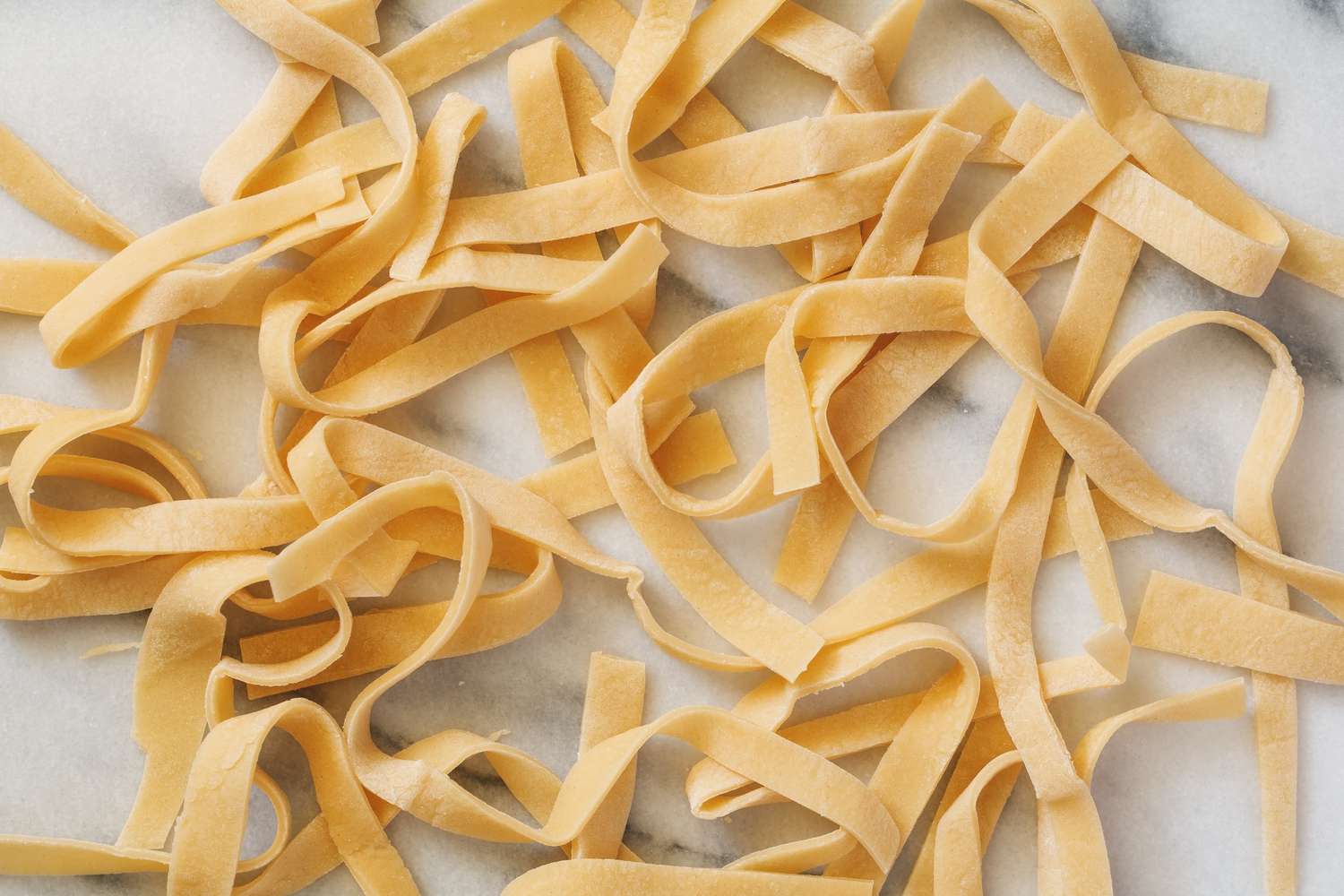

Articles
How To Store Homemade Egg Noodles
Modified: December 7, 2023
Discover the best articles on how to store your homemade egg noodles for perfect freshness and flavor. Learn expert tips and tricks to extend their shelf life.
(Many of the links in this article redirect to a specific reviewed product. Your purchase of these products through affiliate links helps to generate commission for Storables.com, at no extra cost. Learn more)
Introduction
In today’s fast-paced world, convenience foods are often the go-to option for many people. However, there is something truly special about making homemade dishes from scratch. One such dish that brings warmth to the heart and soul is homemade egg noodles. These delectable noodles are not only simple to make, but they also offer a comforting flavor that is hard to resist.
Whether you are an experienced cook or a beginner, making homemade egg noodles is a rewarding and fulfilling experience. Not only do you have complete control over the ingredients used, but the process itself allows you to connect with the time-honored tradition of pasta-making.
In this article, we will guide you through the step-by-step process of making homemade egg noodles and provide you with valuable tips on how to store them for future use. So, roll up your sleeves, put on your apron, and get ready to embark on a culinary adventure.
Key Takeaways:
- Homemade egg noodles offer a comforting and delicious addition to any pasta dish. By following the step-by-step instructions, you can create flavorful and tender noodles that elevate any recipe.
- Properly stored homemade egg noodles can be a convenient option for quick and delicious meals whenever you crave a comforting pasta dish. Enjoy the satisfaction of having fresh pasta readily available in your kitchen.
Equipment and Ingredients Needed
Before diving into the process of making homemade egg noodles, let’s start by gathering all the necessary equipment and ingredients. Having everything prepared and within reach will make the pasta-making process smooth and enjoyable. Here’s what you’ll need:
Equipment:
- Large mixing bowl
- Whisk or fork
- Rolling pin
- Pasta machine (optional)
- Knife or pizza cutter
- Baking sheet
- Plastic wrap or kitchen towel
Ingredients:
- 2 cups of all-purpose flour
- 1/2 teaspoon of salt
- 3 large eggs
- 1-2 tablespoons of water (if needed)
These basic equipment and ingredients are readily available in most kitchens, making this homemade egg noodle recipe accessible for anyone who wants to give it a try.
Making the Dough
Now that you have all the necessary equipment and ingredients ready, it’s time to start making the dough for your homemade egg noodles. Follow these simple steps:
- In a large mixing bowl, combine the all-purpose flour and salt. Whisk or mix them together until well combined.
- Create a well in the center of the flour mixture. This will be where the eggs and water (if needed) will be added.
- Crack the eggs into the well. Using a fork or whisk, gently beat the eggs without incorporating the surrounding flour.
- Gradually start to pull in small amounts of flour from the sides of the well into the beaten eggs. Continue this process until the mixture becomes too thick to stir.
- At this point, you can use your hands to bring the dough together. Knead the dough inside the bowl until it becomes smooth and elastic. If the dough feels too dry, add a tablespoon of water at a time and continue kneading until it reaches the desired consistency.
It’s important not to rush the kneading process, as this helps develop the gluten in the dough, giving the noodles a firm and chewy texture. Once the dough is well-kneaded, it’s time to let it rest.
Resting the Dough
After the dough has been kneaded to perfection, it’s crucial to let it rest. This resting period allows the gluten to relax and the dough to become more elastic, making it easier to roll out and shape into noodles. Follow these steps to rest your homemade egg noodle dough:
- Shape the dough into a ball and lightly dust it with flour.
- Place the dough back into the mixing bowl and cover it with plastic wrap or a kitchen towel.
- Allow the dough to rest at room temperature for at least 30 minutes. This rest period will help the gluten strands to relax, resulting in a more pliable dough.
While it’s tempting to skip or shorten the resting time, try to resist the urge. Allowing the dough to rest will significantly improve the texture and overall quality of your homemade egg noodles.
While the dough is resting, it’s the perfect time to clean up your workspace and prepare for the next step: rolling and cutting the noodles.
After making homemade egg noodles, allow them to dry completely before storing in an airtight container. This will help prevent them from becoming soggy or sticking together.
Rolling and Cutting the Noodles
Now that your homemade egg noodle dough has had ample time to rest, it’s time to roll it out and cut it into noodles. Follow these steps to achieve perfectly shaped noodles:
- Divide the rested dough into smaller portions. This will make it easier to roll out.
- Take one portion of the dough and flatten it into a rectangular shape using your hands.
- Lightly dust the work surface and the dough with flour to prevent sticking.
- Using a rolling pin, start rolling out the dough from the center towards the edges. Roll in one direction, lifting and turning the dough occasionally to ensure even thickness.
- Continue rolling until the dough is thin and has reached the desired thickness for your noodles. If you prefer thicker noodles, don’t roll the dough too thin.
- Once the dough is rolled out, let it rest for a few minutes to relax the gluten again.
- Next, you have the option to cut the noodles by hand using a knife or pizza cutter, or you can use a pasta machine if you have one. If using a pasta machine, follow the manufacturer’s instructions for rolling and cutting the dough.
- If cutting by hand, lightly dust the rolled-out dough with flour, then fold it into a loose roll and slice it crosswise into your desired noodle width.
- Carefully unravel the sliced noodles and separate them gently to prevent sticking.
Repeat the rolling and cutting process with the remaining portions of the dough until you have all your desired noodles ready to be cooked. It’s important to work efficiently and keep the unused dough covered to prevent drying out.
Drying the Noodles
Once you have cut your homemade egg noodles into the desired shape, it’s time to let them dry. Drying the noodles helps remove excess moisture and prevents them from sticking together when cooked. Here’s how to dry your noodles:
- Prepare a clean, dry surface where you can lay out the noodles to dry. A baking sheet or a clean kitchen towel will work perfectly.
- Arrange the cut noodles in a single layer on the drying surface, ensuring they do not overlap or touch each other. This will prevent them from sticking together during the drying process.
- Allow the noodles to air dry for a few hours or until they become firm to the touch. The drying time may vary depending on the humidity level in your kitchen.
- Periodically flip the noodles over to ensure both sides dry evenly.
It’s important to note that egg noodles are typically dried at room temperature and not cooked immediately after cutting. This drying process enhances the texture and flavor of the noodles, resulting in a more authentic homemade pasta experience.
Once the noodles are dry, they are ready to be stored for future use.
Storing the Noodles
Properly storing your homemade egg noodles is essential to maintain their freshness and quality. Whether you plan to use them in a few days or several weeks, follow these guidelines to store your noodles:
- Ensure that the noodles are completely dry before storing them. Any moisture left in the noodles can lead to mold formation.
- If you want to keep the noodles for a short period, you can simply place them in an airtight container or a resealable plastic bag. Make sure to squeeze out any excess air before sealing to prevent moisture from entering.
- If you want to store the noodles for a longer period, consider freezing them. To freeze the noodles, first, spread them out on a baking sheet and place it in the freezer for a couple of hours. Once the noodles are frozen, transfer them to a freezer-safe bag or container. Frozen homemade egg noodles can last for up to 3 months.
- Label the storage container or bag with the date of preparation to keep track of their freshness.
- When you’re ready to cook the stored noodles, there’s no need to thaw them. Simply drop them directly into boiling water and cook for a few minutes until al dente.
Properly stored homemade egg noodles can be a convenient option for quick and delicious meals whenever you crave a comforting pasta dish.
Now that you know how to store your homemade egg noodles, you can enjoy the satisfaction of having fresh pasta readily available in your kitchen.
Conclusion
Congratulations! You have successfully learned how to make homemade egg noodles from scratch. By following the step-by-step instructions provided in this article, you have not only embarked on a culinary adventure but also gained valuable knowledge and skills in pasta-making.
Homemade egg noodles offer a comforting and delicious addition to your favorite pasta dishes. The process of making them from scratch allows you to control the ingredients, ensuring a high-quality and wholesome meal for yourself and your loved ones.
Remember, the key to achieving the perfect homemade egg noodles lies in the right balance of ingredients, proper kneading, resting the dough, rolling it out, and allowing the noodles to dry before storing them. By dedicating some time and effort, you can create a batch of flavorful and tender noodles that will elevate any recipe.
Whether you choose to cook the noodles immediately or store them for later use, you can now confidently enjoy the convenience of having homemade noodles readily available whenever you crave a comforting pasta dish.
So, go ahead and experiment with different recipes, sauces, and flavors using your homemade egg noodles. Let your creativity shine as you explore the world of pasta-making, and savor the satisfaction that comes from creating a homemade dish that brings joy and warmth to the table.
Now, grab your apron, gather your ingredients and equipment, and start making your own batch of homemade egg noodles. Your taste buds will thank you!
Frequently Asked Questions about How To Store Homemade Egg Noodles
Was this page helpful?
At Storables.com, we guarantee accurate and reliable information. Our content, validated by Expert Board Contributors, is crafted following stringent Editorial Policies. We're committed to providing you with well-researched, expert-backed insights for all your informational needs.















0 thoughts on “How To Store Homemade Egg Noodles”